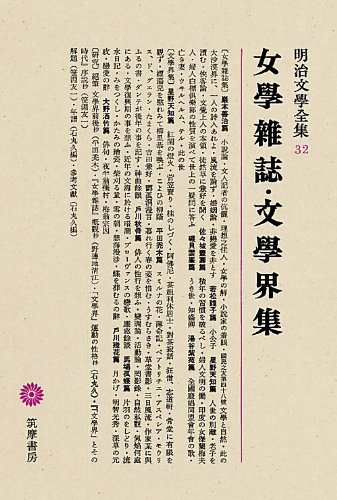2 0 0 0 IR ライシヤーワー教授「十六夜日記」
- 著者
- 笹淵 友一(1902-)
- 雑誌
- 東京女子大學論集
- 巻号頁・発行日
- vol.1, no.2, pp.245-249, 0000
2 0 0 0 OA 「文学界」浪漫主義の性格
- 著者
- 笹淵 友一
- 出版者
- 東京女子大学
- 雑誌
- 東京女子大學論集 (ISSN:04934350)
- 巻号頁・発行日
- vol.6, no.1, pp.1-44, 1955-12-20
a. The members of Bungakukai were, almost without an exception, influenced by the idea of enlightenment, longed for political liberty, and became interested in Western culture. Their longing for political liberty and interest in Western culture had certain Romantic characteristic, but, at the same time, had social, outgoing, frank, materialistic and positive characteristics. The Romanticism observed in Bungakukai seems to have set its position when characteristics turned to be individualistic, internal, secretive, highbrow and idealistic. This change was caused by social failure, the influence of Protestantism and Western literature, ane the investigation into Japanese classics. b. The Main Categories of the Romanticism of Bungakukai 1. Christian Romanticism The influence of Protestanticism made the individuals isolated, metaphysical, and idealistic, and together with Christian literature (for instance, that of Dante and Wordsworth), oriented the individuals to the metaphysical way of thinking. The thirst for elegance transcending all, which is traditional in Japanese literature, may also have contributed, to some extent, to this formation of Romanticism, Its dominant ideas were "idea of inner life", "Platonic love" and "sense of imprisonment". They honoured sublimity, elegance, purity, imagination and inspiration, and considered passion as something ideal. (Tokoku, Tenchi, and other members of Bungakukai in its early period are found in this category.) 2. Dionysiac Romanticism Influenced by Byron, Shelley, Burns, Rousseau, Renan etc., they tried to think that human nature is not constrained. They tended to affirm nature, and they were anti-Christian (or anti-Puritan). (Toson, Shukotsu, Kocho and Tokuboku are found in this category.) 3. Art for Art's Sake AEstheticism, They wanted to be liberated by the power of art from the sense of imprisonment. Those people were influenced by Pater, Keats, Rossetti and other Renaissance artists. (Bin and Tokuboku are found in this category.) The above three categories were the basic styles of Bungakukai, but there was also a gradual development from the first category to the second and the third. (In Toson, both the first and the second categories existed.) c. The Limitation of the Romanticism of Bungakukai The Romantic ideas of the members of Bungakukai are limited by various contradictory ideas, such as, positivism (Taine), naturalism (Zola), realism (Kipling) and the tradition of Japanese literature. The rektion with the tradition of Japanese literature is especially important. We should pay attention to the fact that lyricism, the traditional characteristic of Japanese literature, limited the Western influence on the Romanticism of Bungakukai, especially with regard to its aspiration and imagination. Lyricism in "waka", "haiku", "kanshi" and "joruri", on the one hand, had positive significance concerning the formation of the Romanticism of Bungakukai, but, on the other hand, had a corroding influence on its Western characteristics.
1 0 0 0 OA キリスト教と近代日本文学
- 著者
- 笹淵 友一
- 出版者
- 日本基督教学会
- 雑誌
- 日本の神学 (ISSN:02854848)
- 巻号頁・発行日
- vol.1963, no.2, pp.153-158, 1963-08-10 (Released:2009-09-16)


